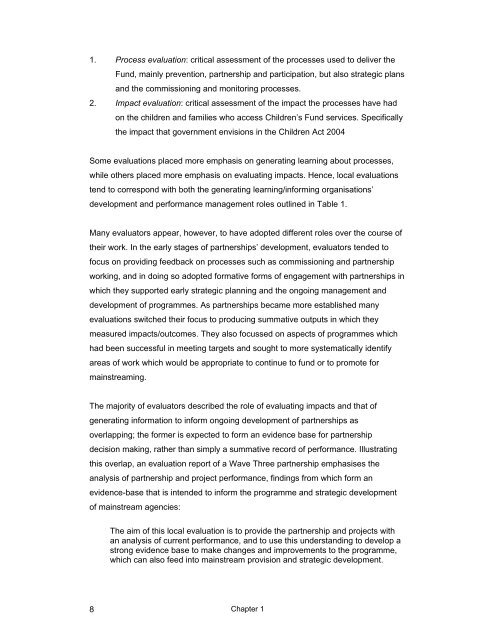Local Evaluation of Children's Services Learning from the Children's ...
Local Evaluation of Children's Services Learning from the Children's ...
Local Evaluation of Children's Services Learning from the Children's ...
- No tags were found...
You also want an ePaper? Increase the reach of your titles
YUMPU automatically turns print PDFs into web optimized ePapers that Google loves.
1. Process evaluation: critical assessment <strong>of</strong> <strong>the</strong> processes used to deliver <strong>the</strong>Fund, mainly prevention, partnership and participation, but also strategic plansand <strong>the</strong> commissioning and monitoring processes.2. Impact evaluation: critical assessment <strong>of</strong> <strong>the</strong> impact <strong>the</strong> processes have hadon <strong>the</strong> children and families who access Children’s Fund services. Specifically<strong>the</strong> impact that government envisions in <strong>the</strong> Children Act 2004Some evaluations placed more emphasis on generating learning about processes,while o<strong>the</strong>rs placed more emphasis on evaluating impacts. Hence, local evaluationstend to correspond with both <strong>the</strong> generating learning/informing organisations’development and performance management roles outlined in Table 1.Many evaluators appear, however, to have adopted different roles over <strong>the</strong> course <strong>of</strong><strong>the</strong>ir work. In <strong>the</strong> early stages <strong>of</strong> partnerships’ development, evaluators tended t<strong>of</strong>ocus on providing feedback on processes such as commissioning and partnershipworking, and in doing so adopted formative forms <strong>of</strong> engagement with partnerships inwhich <strong>the</strong>y supported early strategic planning and <strong>the</strong> ongoing management anddevelopment <strong>of</strong> programmes. As partnerships became more established manyevaluations switched <strong>the</strong>ir focus to producing summative outputs in which <strong>the</strong>ymeasured impacts/outcomes. They also focussed on aspects <strong>of</strong> programmes whichhad been successful in meeting targets and sought to more systematically identifyareas <strong>of</strong> work which would be appropriate to continue to fund or to promote formainstreaming.The majority <strong>of</strong> evaluators described <strong>the</strong> role <strong>of</strong> evaluating impacts and that <strong>of</strong>generating information to inform ongoing development <strong>of</strong> partnerships asoverlapping; <strong>the</strong> former is expected to form an evidence base for partnershipdecision making, ra<strong>the</strong>r than simply a summative record <strong>of</strong> performance. Illustratingthis overlap, an evaluation report <strong>of</strong> a Wave Three partnership emphasises <strong>the</strong>analysis <strong>of</strong> partnership and project performance, findings <strong>from</strong> which form anevidence-base that is intended to inform <strong>the</strong> programme and strategic development<strong>of</strong> mainstream agencies:The aim <strong>of</strong> this local evaluation is to provide <strong>the</strong> partnership and projects withan analysis <strong>of</strong> current performance, and to use this understanding to develop astrong evidence base to make changes and improvements to <strong>the</strong> programme,which can also feed into mainstream provision and strategic development.8Chapter 1
















